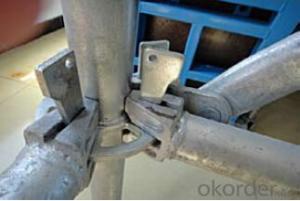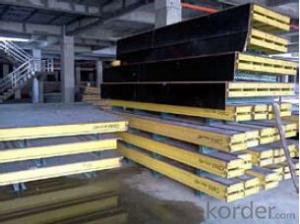Ring-lock Scaffolding Accessories for formwork and scaffolding system
- Loading Port:
- Tianjin
- Payment Terms:
- TT OR LC
- Min Order Qty:
- 50 m²
- Supply Capability:
- 1000 m²/month
OKorder Service Pledge
Quality Product, Order Online Tracking, Timely Delivery
OKorder Financial Service
Credit Rating, Credit Services, Credit Purchasing
You Might Also Like
Ring-lock Scaffolding
A support system for construction, ownsadvantages of both cup-lock scaffolding andshoring tower.
It is in the development direction of new typescaffolding.
It is widely used in buildings, bridges, tunnels etc..
Characteristics:
◆ Easy to storage and transportation
◆ High degree of standardization
◆ Easy and quick erection
◆ Excellent stability and bearing capacity


- Q:Can steel formwork be used in high-rise construction?
- Yes, steel formwork can be used in high-rise construction. Steel formwork offers several advantages that make it suitable for high-rise construction projects. Firstly, steel formwork is strong and durable, capable of withstanding the high pressure of concrete placement in tall structures. It provides stability and rigidity, ensuring the formwork remains intact during the construction process. Additionally, steel formwork is versatile and can be easily customized to meet the specific requirements of high-rise buildings. It can be easily adjusted and reconfigured to accommodate various shapes and sizes, allowing for flexible and efficient construction. Steel formwork also provides a smooth and high-quality finish to concrete surfaces, which is crucial for high-rise buildings that require aesthetic appeal. Moreover, steel formwork is reusable, reducing the overall cost of construction. Unlike traditional timber formwork, steel formwork can be dismantled and reused multiple times, making it a cost-effective solution for high-rise projects. This also reduces waste and promotes sustainability in construction. Lastly, steel formwork offers enhanced safety during high-rise construction. Its strength and stability minimize the risk of accidents and collapses, creating a safer working environment for construction workers. In conclusion, steel formwork can indeed be used in high-rise construction due to its strength, versatility, cost-effectiveness, and safety features. It is a reliable and efficient solution that meets the unique requirements of tall structures.
- Q:What are the different finishes available for steel formwork?
- There are several different finishes available for steel formwork, depending on the desired appearance and functionality of the final product. Some of the most common finishes include: 1. Smooth finish: This is the most basic finish option, where the steel formwork is left as is without any additional treatment. It provides a clean and simple appearance, but it may not be suitable for applications where increased durability or corrosion resistance is required. 2. Galvanized finish: Steel formwork can be hot-dip galvanized, which involves coating the surface of the steel with a layer of zinc. This finish provides excellent corrosion resistance, making it suitable for outdoor applications or structures exposed to moisture. 3. Powder coating: Powder coating is a popular finish option for steel formwork. It involves applying a dry powder to the surface of the steel and then baking it in an oven to create a durable and attractive finish. Powder coating provides excellent corrosion resistance and can be customized to achieve different colors and textures. 4. Epoxy coating: Epoxy coatings are commonly used in industrial settings where chemical resistance is required. These coatings create a protective layer on the steel formwork, making it resistant to chemicals, abrasion, and moisture. Epoxy coatings can also be customized with different colors and textures. 5. Paint finish: Steel formwork can be painted with various types of paint, such as enamel or latex, to achieve a desired appearance. Paint finishes provide some level of corrosion resistance, but they may not be as durable as other finish options. It is important to consider the specific requirements and conditions of the project when selecting the appropriate finish for steel formwork. Factors such as the intended use, exposure to elements, and aesthetic preferences should be taken into account to ensure the desired outcome.
- Q:Can steel formwork be used in areas with high humidity?
- Steel formwork is a suitable choice for areas with high humidity due to its durability and resistance to moisture. Unlike wood, steel does not absorb water or become damaged by humidity. It remains unaffected by warping, swelling, or rotting in high humidity conditions. Additionally, the smooth surface of steel formwork prevents the growth of mold or mildew. Nevertheless, it is crucial to implement proper surface protection and maintenance to prevent corrosion from prolonged exposure to high humidity. Regular cleaning and the application of protective coatings can effectively prolong the lifespan of steel formwork in humid areas.
- Q:How does steel formwork contribute to the overall cost-effectiveness of the construction process?
- Steel formwork contributes to the overall cost-effectiveness of the construction process in several ways. Firstly, steel formwork is reusable, allowing it to be used on multiple construction projects. This eliminates the need for frequent purchases or rentals of formwork, reducing costs in the long run. Secondly, steel formwork is durable and can withstand high pressures and loads, resulting in less damage or need for repairs during the construction process. This reduces downtime and saves on additional expenses. Lastly, steel formwork is highly efficient and can be assembled and disassembled quickly, saving labor costs and speeding up the construction timeline. Overall, the cost-effectiveness of steel formwork lies in its reusability, durability, and efficiency, making it a cost-saving choice for construction projects.
- Q:How does steel formwork prevent concrete spillage?
- Steel formwork prevents concrete spillage by providing a strong and rigid structure that holds the wet concrete in place during the pouring and curing process. The steel panels create a tight enclosure around the concrete, preventing any leakage or spillage, ensuring that the concrete is properly contained within the desired shape and form.
- Q:Can steel formwork be easily customized?
- Certainly! Steel formwork offers great flexibility in customization. Its highly versatile nature enables it to be easily molded, shaped, and transformed into different configurations to meet the specific needs of any construction project. By cutting, bending, welding, and fabricating steel, customized formwork systems can be created to perfectly match the unique shape and dimensions of a structure. This adaptability allows for the construction of intricate geometries, curves, and patterns, making steel formwork suitable for a wide range of architectural designs. Moreover, the ability to reuse steel formwork multiple times enhances its customization capabilities and cost-effectiveness even further.
- Q:What are the different types of steel used for formwork construction?
- There are several types of steel commonly used for formwork construction, including mild steel, high-strength low-alloy (HSLA) steel, and reinforced steel. These different types of steel offer varying levels of strength and durability, allowing for the construction of formwork that can withstand the pressures and forces exerted during the concrete pouring process.
- Q:Position of horizontal construction joint of shear wall. The first layer is higher than the standard layer, the large template in accordance with the standard layer, the first part of the difference with the roof can be poured?
- Large template in accordance with the standard layer, the difference between the first part of the roof can be poured?
- Q:What are the different edge protection systems available for steel formwork?
- Some of the different edge protection systems available for steel formwork include edge protectors, guardrails, safety nets, and toe boards.
- Q:Can steel formwork be used for concrete walls and columns?
- Yes, steel formwork can be used for concrete walls and columns. Steel formwork is strong, durable, and can withstand the pressure exerted by the wet concrete. It offers a high level of accuracy and consistency in shaping the concrete structure. Additionally, steel formwork can be reused multiple times, making it a cost-effective choice for construction projects.
1. Manufacturer Overview |
|
|---|---|
| Location | |
| Year Established | |
| Annual Output Value | |
| Main Markets | |
| Company Certifications | |
2. Manufacturer Certificates |
|
|---|---|
| a) Certification Name | |
| Range | |
| Reference | |
| Validity Period | |
3. Manufacturer Capability |
|
|---|---|
| a)Trade Capacity | |
| Nearest Port | |
| Export Percentage | |
| No.of Employees in Trade Department | |
| Language Spoken: | |
| b)Factory Information | |
| Factory Size: | |
| No. of Production Lines | |
| Contract Manufacturing | |
| Product Price Range | |
Send your message to us
Ring-lock Scaffolding Accessories for formwork and scaffolding system
- Loading Port:
- Tianjin
- Payment Terms:
- TT OR LC
- Min Order Qty:
- 50 m²
- Supply Capability:
- 1000 m²/month
OKorder Service Pledge
Quality Product, Order Online Tracking, Timely Delivery
OKorder Financial Service
Credit Rating, Credit Services, Credit Purchasing
Similar products
New products
Hot products
Hot Searches
Related keywords

























